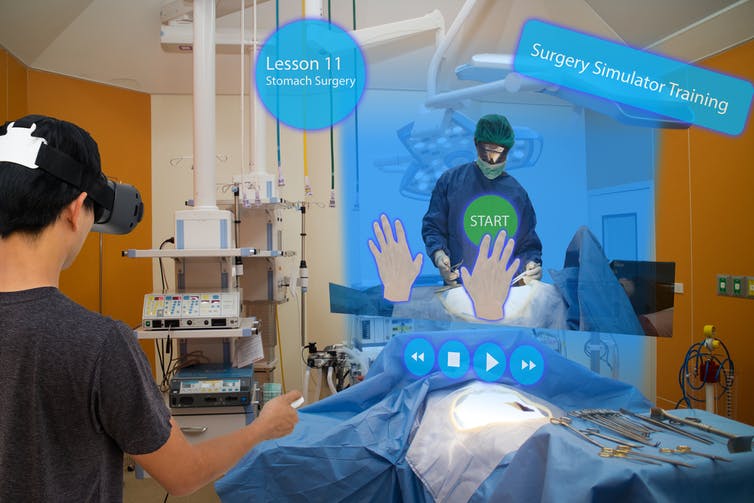Hollywood 360: how virtual reality is poised to take on the traditional movie industry

Shutterstock
The Lawnmower Man was the first feature film to depict a new type of technology that enabled characters to explore synthetic, simulated worlds through an emerging new medium called virtual reality (VR). That was 1992.
Using head-mounted displays (HMD) the size of crash helmets and gloves with sensors, VR users were experiencing computer-generated environments and stories in new ways. Through the idea of “presence” – the feeling of actually being part of an artificially created place – any adventure was now possible, at least if the buzz was to be believed.
The film was a hit; now Hollywood studios were watching, waiting for the technology to mature to a point where they could actually create VR experiences for audiences. This idea of “convergence” between old and new media was a hot topic, and extremely attractive as a potential new revenue stream for studios.
But by 2000, the technology had not progressed substantially. Resolution in headsets was poor and equipment was unreliable and expensive. Many found using VR for more than a few minutes physically nauseating, which doomed its fate.

VR has found success in areas such as medicine, where doctors can practise complex surgeries without risk to human life.
Shutterstock
Hollywood moved its attention elsewhere and VR faded away, maintaining life only through continuing research involving medical and other specialist simulation areas where benefits outweighed the costs.
New horizons
Despite growing interest in sci-fi TV shows and films, VR lay dormant for more than a decade. Then in 2012 the landscape changed. A new start-up company called Oculus announced the development of a new head-mounted display that was lighter, clearer and most importantly, cheaper than past systems.
At first public response was limited, but the announcement sowed the seeds for VR’s return. In 2014, Google announced Cardboard, a simple and inexpensive (often free) system that enables any modern smartphone to function as an head-mounted display.
Samsung took this idea further through the introduction of Gear VR, which uses the Galaxy mobile phone to form its own HMD system. The shift from requiring dedicated hardware to run VR applications to the freedom of using smartphones suddenly expanded the potential VR market to tens of millions.
Offerings from tech giants HTC and Sony soon followed and the VR hype returned. Predictions from Goldman Sachs and others trumpeted a new VR market worth $80 billion by 2025.
Unlike the first wave of VR systems, which relied solely on computer-generated imagery, these new products spurred the development of an additional type of VR content – 360° video or “Cinematic Virtual Reality” (CVR).
Oculus/YouTube.
Whereas traditional VR allows the user complete autonomy to move within a virtual space, with CVR the user has no real control other than where they look as the video plays. But because it uses pre-rendered pictures and sound, CVR programmes can approach the quality found in high-end television or films, and involve real people shot in actual physical locations. Recognising the power of this new format, YouTube and Vimeo both added 360° video playback services providing the public with easy access to CVR content.
Big guns on board
The first major producers of CVR have been news organisations looking to “put viewers in stories” on location. The New York Times is the largest with its free Daily 360 service.
In 2016, it commissioned Great Performers: LA Noir, a series of dramatic CVR shorts involving big-name Hollywood talent. Around the same time, the Sundance Film Festival introduced a VR strand to its New Frontier showcase.
In January 2018, Protozoa Pictures – the production company founded by acclaimed director Darren Aronofsky (Black Swan) – signed a seven-figure deal for a new three-part VR series about exploring space, called Spheres.
So does this mean that Hollywood has finally embraced virtual reality? Arguably yes, but the question is, for how long? Disney has invested over US$65m in the CVR portal and distributor Jaunt VR, and Facebook, which has been in discussions with major studios to create its own TV productions, acquired Oculus for US$2 billion.
Yet there is no indication that significant revenue is flowing. Outlets such as NYT and CNN and the BBC use CVR content to drive traffic to their websites rather than generate income directly, considering value in increased viewer numbers.

Early VR headsets made some users feel nauseous.
Shutterstock
Despite the rapid expansion of VR in all its forms, there are still no established distribution mechanisms that enable companies to recoup their investments in VR production, let alone generate profit. In fact, financial analysts have noted that overall, VR industry revenue was lower than expected for much of 2017 although it has started to rebound.
So, while deals like Spheres are intriguing and noteworthy, it is far too early to say that virtual reality has become a mainstream medium. Headsets are still cumbersome, and watching VR programmes can still make some nauseous.
The current wave of interest in VR has many similarities with its rise and fall 20 years ago. But we only need look at Hollywood’s numerous dalliances with 3D – yet to be successfully established as an alternative film or television format – to wonder about the fate of VR. Whether the industry ultimately embraces it will depend on the technology winning over audiences with an improved experience that is more comfortable, affordable and engaging.

John Mateer has received funding from the Arts and Humanities Research Council (AHRC) and Innovate UK for Knowledge Transfer projects involving the use of digital technologies in feature film production as well as cinematic virtual reality.







